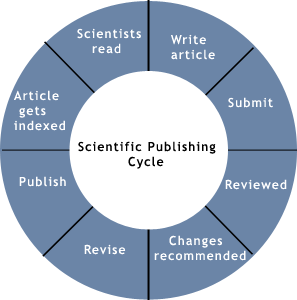
Scientific Information
The advancement of science depends on the sharing of data, observations, results, and interpretations. This communication can take the form of talking or emailing with colleagues and attending or presenting at professional meetings. To reach the widest possible audience, scientists publish in scholarly journals. The most common type of publication in a scholarly journal is the scientific research article.
The following diagram illustrates the cycle of scientific information. As information moves through this process, it becomes increasingly formalized. As information is published, it is read and guides the future work of scientists. Start at “Write article” and go clockwise:

- Write article
- Submit
- Reviewed
- Changes recommended
- Revise
- Publish
- Article gets indexed
- Scientists read
Scholarly Journals
In addition to the scientific research article, scholarly journals publish other types of articles. For the most part, only the research article is considered a primary literature source. Types of journal articles in scholarly journals may include:
- scientific research articles: describe original research (not a summary of others’ research) and include descriptions of experiments, methods, and results.
- review articles: provide a summary or overview of research in a field. They may include figures, but they are not reporting original research. Useful when you need background information and additional references.
- editorials, essays, opinion pieces, letters to the editor: are meant to convey someone’s thoughts or opinions on a topic, and not necessarily factual information.
- news items: often very brief summaries of others’ research
- meeting abstracts or proceedings: provide brief descriptions of original research presented at conferences. Useful when you are looking for recent research in the scientific literature.
Scientific research articles are most useful for academic research because they are considered primary literature and they:
- Are written by scientists and published in scientific journals
- Are written for other scientists
- Use technical terms and scientific jargon, assuming that readers understand scientific concepts and research
- Report on the results of a scientific research project and usually include data and results in the form of tables, graphs, and figures
- Go through a “peer review” process in which other scientists review the articles before they are published
- Follow a specific format with definite sections